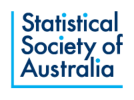Sieves help us cook pasta and rice, whilst bootstraps come in handy when donning a pair of boots. The September 2021 seminar to the New South Wales branch had nothing to do with cooking or dressing. However, statistics has borrowed these terms quite heavily and Professor Han Lin Shang of Macquarie University's Department of Actuarial Studies and Business Analytics explained how statistical sieves and statistical bootstraps aid the analysis of functional time series data.
The main parameter of interest throughout the talk was the memory parameter when the time series exhibited long-range dependence. A central question is obtaining confidence intervals for this parameter and a recent Journal of the American Statistical Association paper by the author and two co-authors addressed this problem.
The rise of functional time series data is due to ongoing improvements in technology, such as functional magnetic resonance imaging for measuring brain function. Han Lin described functional data in stochastic process terms and how functional time series arise when the time series index is a continuous time variable. Despite the continuum aspect of the framework, in practice the measurements are at discrete time points. Professor Shang explained the difference between dense and sparse functional data - with the former having high sampling frequency. Various theoretical constructs such as continuous time covariance functions, Mercer's representation, Karhunen-Loeve expansion and functional auto-regressive integrated moving average models were explained as being useful for analysis of functional time series data.
Then speaker Shang discussed long-memory processes and formally introduced the memory parameter. Various estimators were described and, based on the speaker's 2020 simulation study, methodology by time series researchers Peng and Whittle were recommended. After that, the branch was told how sieve bootstrapping can be used to obtain confidence intervals for the memory parameter. Simulation results showed good performance of Professor Shang's new methodology.
At the end of the presentation it was pointed out that the sieve bootstrap approach can be applied to any memory parameter, whilst asymptotic confidence intervals are only possible for a selected range of memory estimators.
Matt Wand, University of Technology Sydney
